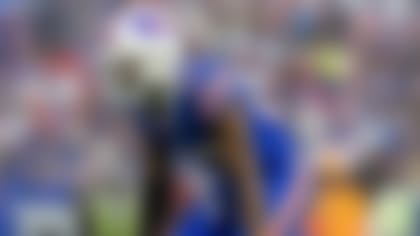Many of our NFL Network analysts dedicated years to perfecting their craft and becoming the best players they could during their respective football careers, navigating difficult decisions along the way. What were the best decisions they made? What were their biggest regrets? Below, nine analysts reflect on their time in the NFL and reveal the best decisions they made during their careers. Click here for the biggest regrets.
LaDainian Tomlinson, running back (San Diego Chargers, 2001-09; New York Jets, 2010-11): In 2009, a lot of people thought I was done after recording a career-low 730 rushing yards for the San Diego Chargers. The following offseason, I knew it was time to leave San Diego and start a new chapter in my career. The best decision I could have made was signing with the New York Jets at that time. I was able to bounce back with a good season. I helped my team get to the AFC Championship Game. I was featured in a national commercial. That season justified my decision to join Rex Ryan and the Jets -- forgoing a deal with Minnesota -- and that was a great feeling.
James Jones, wide receiver (Green Bay Packers, 2007-2013, 2015; Oakland Raiders, 2014): I was a free agent in 2011 after four years with the Packers and had opportunities to play elsewhere for more money. I decided to re-sign with the Packers for less money, because it felt bigger than money. Green Bay was home, and the fit couldn't have been more perfect.
Joe Thomas, offensive tackle (Cleveland Browns, 2007-2017): During my college and NFL careers, I had four knee surgeries, countless ligament tears, muscle tears and arthritis in most of my joints. I am no stranger to injury, but as my NFL career (and my consecutive snap streak) progressed, I became obsessed with taking care of my body. I constantly searched for ways to feel better, implementing yoga and religious stretching in my daily routine. Late in my career, I had a strength coach that was dedicated to bringing my stretch band out to the practice field. I took advantage of any down time to work on my flexibility and mobility and took the time to learn and understand why I did certain exercises. By the end of my career, I knew every muscle group and trained my mind like I had trained my body, so much so that I knew I was going to tear my triceps in my last season in 2017, which snapped my streak. Looking back on my career, I am so glad that I did everything possible to take care of my body. I wouldn't have been able to play as long as I did without doing so.
Brian Baldinger, offensive lineman (Dallas Cowboys, 1982-87; Indianapolis Colts, 1988-1991; Philadelphia Eagles, 1992-93): After my 1991 NFL season in Indianapolis, in which I took over for Ray Donaldson at center when he suffered a broken leg in the third game of the season, I ended up being the offensive MVP of a horrible team (we were 1-15 that season). My contract was up, and a coaching change was imminent. I could have stayed in Indy for OK money, but the Buffalo Bills -- off a Super Bowl loss to Washington -- came calling in free agency. Going into my 11th season, I wanted a chance to contend for a Super Bowl ring. Plus, my youngest brother, Gary, was on the team. I signed with Buffalo and spent my offseason there working out and getting to know my teammates. I had never experienced such a close-knit family atmosphere on any team. Head coach Marv Levy was smart, organized and in charge. They had a variety of leaders throughout the locker room and star players at every position, many of whom are in the Hall of Fame. I couldn't wait for camp to begin.
In training camp, I had clearly proven myself as the sixth best offensive lineman. Unfortunately, Levy cut me at the end of training camp, and it devastated me for several weeks. That is, until the Philadelphia Eagles came calling. But that short stint with the Bills taught me so much. I learned what a close team was all about, and that the Bills were that way because of more than just talent. I learned that disappointment is part of life, and I was reminded that everything happens for a reason. I ended up in Philly as a result of getting cut, loving it so much that I made it my home.
Willie McGinest, defensive end/outside linebacker (New England Patriots, 1994-2005; Cleveland Browns, 2006-08): One reason I was able to play 15 years in the NFL is because I started working with Alex Guerrero. I was immediately sold on his method and approach to injury prevention and worked with him in the early 2000s -- even flying him to New England at times. Guerrero was eventually allowed to come to the Patriots' facilities to work on me and my teammates. He's worked with so many professional athletes over the years and extended so many careers. Just look at my former teammate Tom Brady. He's still playing at a high level and will be 43 years old in August.
DeAngelo Hall, cornerback (Atlanta Falcons, 2004-07; Oakland Raiders, 2008; Washington Redskins, 2008-2017): I think I went through almost every emotion in the book in 2008. In March, the Falcons traded me to the Oakland Raiders, and I signed the biggest contract of my career. The joy of that move was cut short when the team released me eight months later. That was a miserable feeling. Not only had I not lived up to my contract, but I had to find a new home midway through the season. Three days after my release, I signed with Washington, fulfilling my dream of playing at home and joining a loaded secondary that featured Fred Smoot, LaRon Landry, Carlos Rogers and Shawn Springs. The high of coming home was especially emotional several weeks later, when the team honored Sean Taylor on the one-year anniversary of his death. We were in the same draft class, and we talked about playing together someday in Washington; I had actually tried to work out a trade in 2007, the year Taylor died. I was in tears that day on the sideline, thinking about what could have been and what would never be. I finished out the 2008 season and signed a six-year deal with Washington the following offseason, ensuring that I finished my playing career at home.
Maurice Jones-Drew, running back (Jacksonville Jaguars, 2006-2013; Oakland Raiders, 2014): My running backs coach in Jacksonville, Kennedy Polamalu, told me one offseason that I should watch other backs around the league and implement their styles into my own game. I really dedicated time to doing so, and it made me more versatile. I studied Adrian Peterson's stiff-arm, Frank Gore's vision (to get skinny through a hole), LeSean McCoy's open-field moves, etc. Adding different aspects to my game was a big reason I was able to win the rushing title in 2011.
David Carr, quarterback (Houston Texans, 2002-06; Carolina Panthers, 2007; New York Giants, 2008-09 and 2011-12; San Francisco 49ers, 2010): After two seasons with New York Giants, I signed with the 49ers in 2010. It was an opportunity for me to earn another QB1 spot late in my career, but Alex Smith ended up being their guy. Then, in 2011, Jim Harbaugh came in -- signing another QB in Colin Kaepernick -- and I just felt like it was my time to leave San Francisco, even though I did want to play for him. I asked for my release just ahead of training camp, so I was all packed up with nowhere to go. Several days later, I called Tom Coughlin in New York, told him I was a free agent and re-joined the Giants almost immediately. Going back to New York to finish out my career (we also won the Super Bowl in '11) was hands down the best decision I made in my career.
Nate Burleson, wide receiver (Minnesota Vikings, 2003-05; Seattle Seahawks, 2006-09; Detroit Lions 2010-2013): In 2010, I had just finished a four-year stint with my hometown team, the Seattle Seahawks, and originally planned on re-signing with them. I did have other options, but Seattle was a good fit. But on the night free agency opened, then-Detroit Lions offensive coordinator Scott Linehan came to Seattle to recruit me. At 12:01 a.m., he was at a restaurant ready to negotiate. I felt like the cute girl at the prom that somebody wanted to dance with. After meeting with Linehan, who sold me by making me a priority, I knew I was going to sign with Detroit. Remember, in 2010, Detroit was just two years removed from finishing 0-16. There was this cloud over the city when it came to football. I signed in the hopes of helping an underdog become relevant and ended up falling in love with a city that needed it.



